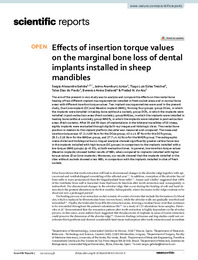Por favor, use este identificador para citar o enlazar este ítem:
https://hdl.handle.net/11000/27574Registro completo de metadatos
| Campo DC | Valor | Lengua/Idioma |
|---|---|---|
| dc.contributor.author | Gehrke, Sergio | - |
| dc.contributor.author | Aramburú Júnior, Jaime | - |
| dc.contributor.author | EirlesTreichel, Tiago Luis | - |
| dc.contributor.author | Dias do Prado, Tales | - |
| dc.contributor.author | Anina Dedavid, Anina Dedavid | - |
| dc.contributor.author | De Aza, Piedad | - |
| dc.date.accessioned | 2022-07-27T10:09:48Z | - |
| dc.date.available | 2022-07-27T10:09:48Z | - |
| dc.date.created | 2022-01-11 | - |
| dc.identifier.citation | Scientific Reports volume 12, Article number: 538 (2022) | es_ES |
| dc.identifier.uri | https://hdl.handle.net/11000/27574 | - |
| dc.description.abstract | The aim of the present in vivo study was to analyze and compare the effects on the crestal bone healing of two different implant macrogeometries installed in fresh socket areas and in normal bone areas with different insertion torque values. Two implant macrogeometries were used in the present study, DuoCone implant (DC) and Maestro implant (MAE), forming four groups: group DCws, in which the implants were installed in healing bone (without a socket); group DCfs, in which the implants were installed in post-extraction areas (fresh sockets); group MAEws, in which the implants were installed in healing bone (without a socket); group MAEfs, in which the implants were installed in post-extraction areas (fresh sockets). After 30 and 90 days of implantations in the bilateral mandibles of 10 sheep, eighty implants were evaluated through digital X-ray images and histologic slices. The crestal bone position in relation to the implant platform shoulder was measured and compared. The measured insertion torque was 47.2 ± 4.69 Ncm for the DCws group, 43.4 ± 4.87 Ncm for the DCfs group, 29.3 ± 3.16 Ncm for the MAEws group, and 27.7 ± 4.41 Ncm for the MAEfs group. The radiographic mesio-distal and histological bucco-lingual analyses showed significantly greater vertical bone loss in the implants installed with high torque (DC groups) in comparison to the implants installed with a low torque (MAE groups) (p < 0.05), at both evaluation times. In general, low insertion torque values (Maestro implants) showed better results of MBL when compared to implants installed with higher torque values (Duo Cone implants). Moreover, our results showed that the implants installed in the sites without sockets showed a less MBL in comparison with the implants installed in sites of fresh sockets. | es_ES |
| dc.description.sponsorship | Part of this work was supported by Ministry of Science and Innovation—Grant PID2020-116693RB-C21 funded by MCIN/AEI/10.13039/501100011033. | - |
| dc.format | application/pdf | es_ES |
| dc.format.extent | 13 | es_ES |
| dc.language.iso | eng | es_ES |
| dc.rights | info:eu-repo/semantics/openAccess | es_ES |
| dc.rights | Attribution-NonCommercial-NoDerivatives 4.0 Internacional | * |
| dc.rights.uri | http://creativecommons.org/licenses/by-nc-nd/4.0/ | * |
| dc.subject.other | CDU::6 - Ciencias aplicadas::62 - Ingeniería. Tecnología | es_ES |
| dc.title | Efects of insertion torque values on the marginal bone loss of dental implants installed in sheep mandibles | es_ES |
| dc.type | info:eu-repo/semantics/article | es_ES |
| dc.contributor.institute | Institutos de la UMH::Instituto de Bioingeniería | es_ES |
| dc.identifier.doi | 10.1038/s41598-021-04313-5 | - |
| dc.relation.publisherversion | https://doi.org/10.1038/s41598-021-04313-5 | - |

Ver/Abrir:
Scientific Repors Sergio.pdf
3,25 MB
Adobe PDF
Compartir:
 La licencia se describe como: Atribución-NonComercial-NoDerivada 4.0 Internacional.
La licencia se describe como: Atribución-NonComercial-NoDerivada 4.0 Internacional.
.png)